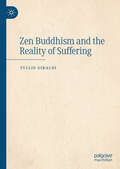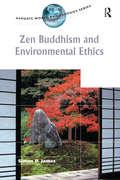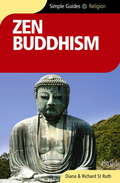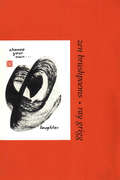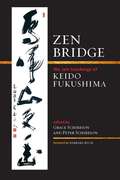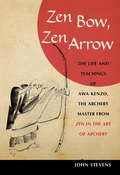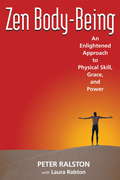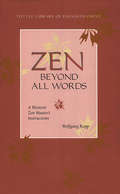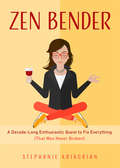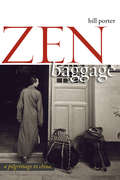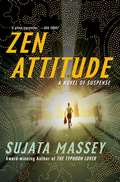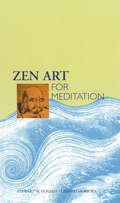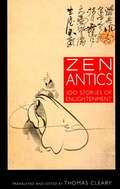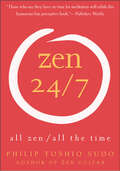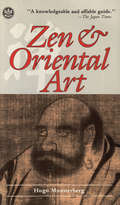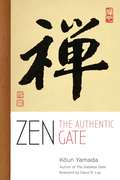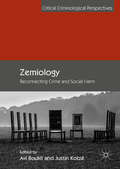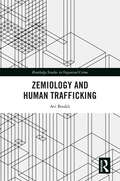- Table View
- List View
Zen Buddhism and the Reality of Suffering
by Tullio GiraldiThis book offers an accessible guide to the role that Zen has played and, alongside Buddhism, might play in both Eastern and Western attempts to alleviate mental suffering. Since its beginnings 2500 years ago, the central belief of Buddhism has been that what we perceive as “reality” is a mental representation; a religious belief which has since been substantiated by the evidence of neuroscience. The work and progress of clinical medicine, psychiatry and psychology have attempted to alleviate the sufferings of life, but the current approaches to mental health in psychiatry, the neurosciences and cognitivism don't fully address the complexity and mutual inter-relationship of the variety of factors involved in mental suffering, and its non-linear and chaotic aspects. Zen Buddhism, on the other hand, encourages access to reality, and so this book will explore, scientifically, the ways in which it’s guiding principles can be deployed to support and enhance Western, clinical solutions to mental strife.
Zen Buddhism and Environmental Ethics (Ashgate World Philosophies Series)
by Simon P. JamesZen Buddhism and Environmental Ethics explores the implications of Zen Buddhist teachings and practices for our moral relations with the natural world. At once an accessible introduction to Zen and an important contribution to the debate concerning the environmental implications of the tradition, this book will appeal both to readers unfamiliar with East Asian thought and to those well versed in the field. In elucidating the philosophical implications of Zen, the author draws upon both Eastern and Western philosophy, situating the Zen understanding of nature within the Buddhist tradition, as well as relating it to the ideas of key Western philosophers such as Aristotle, Kant and Heidegger. These philosophical reflections on Zen are used to shed light on some prominent debates in contemporary environmental ethics concerning such issues as the intrinsic value of nature.
Zen Buddhism - Simple Guides
by Diana St. RuthTHIS BOOK WILL HELP YOU* to appreciate the significance of this particular school of Buddhism,famous for its focus on meditation and self-awakening* to understand the history of Zen and the 'Ways of Zen'* to discover how Zen is a way of life -- not a belief system* to avoid faux pas in conversation, in travelling and in personal relationships. Zen (in Chinese, Ch'an) is the form of Buddhism which the great teacher Bodhidharma brought to China from India in the late fifth century. Today it is practised mainly in Japan and Korea,. Based upon the understanding that each of us has the potential for complete awakening, Zen is in fact a coalition of practical ways of stilling the mind in order to attain self-knowledge. Because the realization of the true nature of reality, including one's own, is not an intellectual pursuit but an experienced truth, Zen teachers transmit the truth (dharma) from mind to mind or heart to heart without the use of words, using different techniques to break through the limitations of the logical mind. This engaging book explains the essence of Zen in simple terms. It traces its development and looks at its unique methods of teaching, such as meditation, koans -- startling paradoxes that stop the intellect -- the use of texts, ceremonies, poetry, and the martial arts. It describes life in monasteries and in the everyday world. Because Zen is rooted in Reality, its practitioners often experience a delightful sense of wonder in the commonplace. This democratic and liberating philosophy does not require us to give up our own traditions, but rather helps us to deepen our understanding of them, and continues to inspire growing numbers of followers in the West.
Zen Brushpoems
by Ray GriggZen Brushpoems connects the creative insights of Haiku-like poetry with the dynamic interplay of the written word and painted image. This subtle and profound medium of poetic expression has been inspired by the revolutionary work of Paul Reps
Zen Brushpoems
by Ray GriggZen Brushpoems connects the creative insights of Haiku-like poetry with the dynamic interplay of the written word and painted image. This subtle and profound medium of poetic expression has been inspired by the revolutionary work of Paul Reps
Zen Brushpoems
by Ray GriggZen Brushpoems connects the creative insights of Haiku-like poetry with the dynamic interplay of the written word and painted image. This subtle and profound medium of poetic expression has been inspired by the revolutionary work of Paul Reps
Zen Brushpoems
by Ray GriggZen Brushpoems connects the creative insights of Haiku-like poetry with the dynamic interplay of the written word and painted image. This subtle and profound medium of poetic expression has been inspired by the revolutionary work of Paul Reps
Zen Bridge: The Zen Teachings of Keido Fukushima
by Grace Schireson Barbara Ruch Keido Fukushima Peter SchiresonA funny, poignant, and illuminating masterclass on Zen philosophy and practice from a beloved teacher.Zen Bridge collects Dharma talks given by the Zen master Keido Fukushima Roshi. Fukushima Roshi's anecdotes on his own training are humble, hilarious, and full of wisdom. His reflections on classical teachings intermingle with personal stories, allowing them to be accessible to all readers while at the same time transcendent. The power and authenticity of this true Zen master shines through in his words. This book includes black and white illustrations of basic sitting and hand posture for meditation as well as selections of Fukushima Roshi's calligraphy.
Zen Bow, Zen Arrow: The Life and Teachings of Awa Kenzo, the Archery Master from Zen in the Art of A rchery
by John StevensHere are the inspirational life and teachings of Awa Kenzo (1880-1939), the Zen and kyudo (archery) master who gained worldwide renown after the publication of Eugen Herrigel's cult classic Zen in the Art of Archery in 1953. Kenzo lived and taught at a pivotal time in Japan's history, when martial arts were practiced primarily for self-cultivation, and his wise and penetrating instructions for practice (and life)--including aphorisms, poetry, instructional lists, and calligraphy--are infused with the spirit of Zen. Kenzo uses the metaphor of the bow and arrow to challenge the practitioner to look deeply into his or her own true nature.
Zen Body-Being: An Enlightened Approach to Physical Skill, Grace, and Power (Zen Buddhism Ser.)
by Peter Ralston Laura RalstonIn this inspiring guide, Peter Ralston presents a program of "physical education" for anyone interested in body improvement. Using simple, clear language to demystify the Zen mindset, he draws on more than three decades of experience teaching students and apprentices worldwide who have applied his body-being approach. More of a transformative guide than a specific list of exercises devoted to any particular physical approach, Zen Body-Being explains how to create a state of mental control, enhanced feeling-awareness, correct structural alignment, increased spatial acuity, and even a greater interactive presence. Exercises are simple, often involving feeling-imagery and meditative awareness, which have a profound and sometimes instant effect. Where similar guides teach readers what to do, this book teaches readers how to be.From the Trade Paperback edition.
Zen Beyond All Words
by Wolfgang Kopp Barbara Wittenberg-HaenauerZen Beyond All Words contains a selection of talks given by MasterWolfgang Kopp at the Tao Ch'an Center in Wiesbaden, Germany, during the summer of 1992. In the spirit of the ancient Chinese Ch'an masters, Wolfgang Kopp teaches a direct and powerful Zen. He conveys neither a theoretical system nor a one-sided dogmatism of sitting, and he neither wears customary robes nor holds a traditional title.
Zen Beyond All Words
by Wolfgang Kopp Barbara Wittenberg-HaenauerZen Beyond All Words contains a selection of talks given by MasterWolfgang Kopp at the Tao Ch'an Center in Wiesbaden, Germany, during the summer of 1992. In the spirit of the ancient Chinese Ch'an masters, Wolfgang Kopp teaches a direct and powerful Zen. He conveys neither a theoretical system nor a one-sided dogmatism of sitting, and he neither wears customary robes nor holds a traditional title.
Zen Bender: A Decade-Long Enthusiastic Quest to Fix Everything (That Was Never Broken)
by Stephanie Krikorian&“The book is filled with humor and soul-baring honesty, as Krikorian describes her adventures down just about every self-help road there is.&” —The Independent When the recession turned her life upside down, Stephanie Krikorian had to reinvent her life—and fast. She started ghostwriting self-help books for women. Between writing and researching she realized that everywhere she looked there was AFOG. Another freaking opportunity for growth. Soon she wasn&’t just writing each book; she was living them. This was the start of a ten-year zen bender of dieting, dating, journaling, meditating, and Marie-Kondo-ing on a quest for that ultimate self-help high. Stephanie Krikorian spent her forties trying all of the dating hacks to find love and respect, all of the diets to build self-esteem in a new body, and all of the spiritual guidance to become centered through self-care. On the brink of turning fifty she realized that being better wasn&’t what she craved; it was something else altogether. Zen Bender is the story of one woman&’s journey to radical acceptance, with some questionable advice along the way. A witty, moving, insightful story, the woman behind bestselling celebrity self-help books shares her story of being hooked on the self-help fix for a decade before learning that all the self-help in the world won&’t help you trust gut. &“A wise, witty and thought-provoking book that tends in just the place you&’d hope it would. A great read whether you have a Reiki healer on speed dial, or, well, not.&” —Marianne Power, author of Help Me!: One Woman&’s Quest to Find Out if Self-Help Really Can Change Her Life
Zen Battles: Modern Commentary on the Teachings of Master Linji
by Thich Nhat HanhOne of the key tenets of the Zen school of Mahayana Buddhism is that each one of us is already a Buddha--our enlightenment is inherent within us, and the practice of mindfulness is the tool to bring this truth to our full awareness. <P> While it can bring much relief, this simple statement does not preclude the need for practice. We must strive to always be aware of our Buddha nature, rather than waiting until times of emotional upheaval when it is more difficult to practice. Thich Nhat Hanh uses the teachings of ninth century Zen Master Linji to elaborate on this simple truth and to give readers tools that can help awaken them to their true inner nature. Linji's recorded teachings are the most significant we have from the Ch'an school.One of the unique aspects of Linji's teaching, is the need to "wake ourselves up," not only by means of sitting meditation and listening to enlightened teachings, but also through unique techniques such as the shout, the stick, and the empty fist. Master Linji emphasized direct experience of our true nature over intellectual explorations of the teachings, and he encouraged his students to not "become lost in the knowledge or the concepts of the teaching."Powerful, direct, and uncompromising, Thich Nhat Hanh's reflections on the teachings of Master Linji are destined to become classic Buddhist writings.
Zen Baggage: A Pilgrimage to China
by Red PineIn the spring of 2006, Bill Porter traveled through the heart of China, from Beijing to Hong Kong, on a pilgrimage to sites associated with the first six patriarchs of Zen. Zen Baggage is an account of that journey. He weaves together historical background, interviews with Zen masters, and translations of the earliest known records of Zen, along with personal vignettes. Porter's account captures the transformations taking place at religious centers in China but also the abiding legacy they have somehow managed to preserve. Porter brings wisdom and humor to every situation, whether visiting ancient caves containing the most complete collection of Buddhist texts ever uncovered, enduring a six-hour Buddhist ceremony, searching in vain for the ghost in his room, waking up the monk in charge of martial arts at Shaolin Temple, or meeting the abbess of China's first Zen nunnery. Porter's previously published Road to Heaven: Encounters with Chinese Hermits has become recommended reading at Zen centers and universities throughout America and even in China (in its Chinese translation), and Zen Baggage is sure to follow suit.
Zen Attitude
by Sujata MasseyIt's Tough to Keep Cool When the Heat Is On Japanese-American Rei Shimura finally has a life to be proud of in Tokyo: running her own antiques business and living with her Scottish lawyer boyfreind. But when Rei overpays for a beautiful chest of drawers, she's in for the worst deal of her life. The con man who sold her the Tansu is found dead, and like it or not Rei's opened a pandora's box of mystery, theft, and murder. Only Rei sees the Tansu as the key. It will take a quick wit, fast feet, and above all a Zen Attitude for Rei to discover what a young monk, a judo star, and an ancient scroll have in common, and why her own life hangs in the balance. Sujata Massey is an exciting new author published by HarperPaperbacks. Massey's first novel, The Salaryman's Wife, has just been nominated for the prestigious Anthony Award. Massey's second novel, Zen Attitude, also featuring Rei Shimura, a 27 year-old Japanese American English teaching living in Tokyo, will be out in June 1998.
Zen Art for Meditation
by Stewart W. Holmes Chimyo HoriokaThis book is about emptiness and silence—the mind-expanding emptiness of Zen painting, and the reverberating silence of haiku poetry. Through imaginative participation in the visions of painters and poets, its readers are led to the realization that, in the author's words, "emptiness, silence, is not nothingness, but fullness. Your fullness. " This cultural tradition has informed many distinguished lives and works of art. The work of painters like Niten, Liang K'ai, and Toba, and of painters like Basho, Buson, and Issa reflects the wholeness, spontaneity, and humanity of the Zen vision. Those who desire a glimpse into the world of intuitive contact with nature offered by Zen meditation will find these paintings, commentaries, and haiku poems especially rewarding. They enable the reader to experience the unique power of Zen art—it's capacity to fuse esthetic appreciation, personal intuition, and knowledge of life into one creative event.
Zen Antics
by Thomas ClearyThroughout Zen history, stories and anecdotes of Zen masters and their students have been used as teaching devices to exemplify the enlightened spirit. Unlike many of the baffling dialogues between Zen masters preserved in the koan literature, the stories retold here are penetratingly simple but with a richness and subtlety that make them worth reading again and again. This collection includes more than one hundred such stories--many appearing here in English for the first time--drawn from a wide variety of sources and involving some of the best-known Zen masters, such as Hakuin, Bankei, and Shosan. Also presented are stories and anecdotes involving famous Zen artists and poets, such as Sengai and Basho.
Zen 24/7: All Zen, All the Time
by Philip Toshio Sudo“Those who say they have no time for meditation will relish this humorous but perceptive book.” —Publishers WeeklyEnlightenment is within reach—twenty-four hours a day, seven days a week.If you're searching for revelation and contentment, look no further than a handshake, a cup of coffee—even your laundry pile. The most mundane details of life contain zen's profound truths, if you're of the mind to look for them.By awakening to and embracing the zen in your life, you'll listen, watch, eat, work, laugh, sleep, and breathe your way to truth—every moment of every day.“With an ease that comes from spiritual maturity, Sudo delivers one marvel after another in this astute reading of zen truths residing in work, exercise, eating, laughter, and sleep . . . Sudo makes the spiritual practices of attention, being present, gratitude, and wonder come to life on these pages. You'll never be the same after reading Zen 24/seven.” —Spirituality & Practice“Sudo explains how to turn the most ho-hum activities into opportunities for transcendence.” —Fitness magazine
Zen & Oriental Art
by Hugo MunsterbergZen & Oriental Art is an indispensable, beautifully illustrated introduction to the influences of Zen on Oriental painting. folk art, and architecture, with a special section on the role of Zen in twentieth-century art and architecture in the West. Dr. Munsterberg quite naturally begins with an explanation of Zen Buddhism itself, and the historical development of Zen in India and China. Zen's particularly rapid adoption in Japan is covered in the next chapter, which is followed by sections on the Zen art of ink painting in both China and Japan. Also described are the influences of Zen on Japanese architecture, and the intimate connection of the religion with the Japanese tea ceremony. Of particular interest to Western readers is the chapter on Zen andtwentieth-century Western art.
Zen & Oriental Art
by Hugo MunsterbergZen & Oriental Art is an indispensable, beautifully illustrated introduction to the influences of Zen on Oriental painting. folk art, and architecture, with a special section on the role of Zen in twentieth-century art and architecture in the West. Dr. Munsterberg quite naturally begins with an explanation of Zen Buddhism itself, and the historical development of Zen in India and China. Zen's particularly rapid adoption in Japan is covered in the next chapter, which is followed by sections on the Zen art of ink painting in both China and Japan. Also described are the influences of Zen on Japanese architecture, and the intimate connection of the religion with the Japanese tea ceremony. Of particular interest to Western readers is the chapter on Zen andtwentieth-century Western art.
Zen
by Roshi P. KapleauIn this companion volume to The Three Pillars of Zen, Kapleau establishes guidelines for Western practitioners of Zen Buddhism, offering appealing, simple answers to the questions Westerners most often ask. Among the topics discussed in this informative, user-friendly book: "Transcendental Meditation: Who Transcends What?", "Can I Practice Zen and Be a Good Jew (or Catholic)?", "Reading About Enlightenment Is Like Scratching an Itchy Foot Through Your Shoe," and "Meditation Is an Escape--What Are You Doing to Help Society?" Kapleau's eloquence, humor, and authority make this an indispensible handbook for understanding Zen in the Western world.
Zen
by Yamada KounWhether a beginner or at the highest level of practice, learn Zen from one of the greatest masters of the twentieth century.Why practice Zen? What sets Zen apart from religion? What are its different practices? <P><P> These questions, and more, are examined and answered by Zen Master Koun Yamada, whose Dharma heirs include Robert Aitken, Ruben Habito, and David Loy. Through compelling stories and a systematic approach, he guides the reader through creating and sustaining a lifelong practice.<P> Warm and ecumenical in tone, Koun uses the insights of Zen to bring a deeper understanding of faith. Zen: The Authentic Gate is an easy-to-follow guide to creating an effortless and natural practice regardless of background, tradition, or religion.
Zemiology: Reconnecting Crime And Social Harm (Critical Criminological Perspectives )
by Avi Boukli Justin KotzéEnhances and develops the critical, harms-based approach within criminology<P><P> Analyses structural change and its social consequences to bring zemiology into dialogue with contemporary debates about capitalism.<P> Brings together international scholars from around the globe to cover a wide range of harms-based crimes.<P> This book challenges the given dichotomies between crime and harm, and criminology and zemiology. The main aim of the volume is to highlight the inexorable interconnectedness between systemically induced social harm and the corrosive flows of everyday crime both perpetrated and endured by those victimised by the capitalist system and its hegemonic vicissitudes. Drawing attention not only to various structurally imbedded harms, the chapters also outline the wider consequences of such harms, as they extend beyond immediate victims and contribute towards the further perpetuation of criminogenic and zemiogenic conditions. <P> Comprising two parts, the first explores the relationship between crime and harm and criminology and zemiology, and the second explores the intersections of crime and harm through various lenses, including those trained on probation; global mobility; sexuality and gender; war and gendered violence; fashion counterfeiting; and the harms of the service economy. An exciting and wide-reaching volume written by world-renowned scholars, this collection is a must-read for students, academics, and policy makers in the fields of law, criminology, sociology, social policy, criminal justice, and social justice.
Zemiology and Human Trafficking (Routledge Studies in Organised Crime)
by Avi BoukliFollowing the rise of the zemiological movement, the concept of social harm has attracted a great deal of scholarly attention. Using this perspective, a number of scholars have sought to remove the constraining brackets surrounding criminological investigation in order to broaden its legitimate parameters of study and incorporate a wider range of un-criminalized and hidden harms. This book expands the literature on social harm by applying the concept of zemia to human trafficking investigations in Europe, North America, and Africa. This book draws attention not only to various structurally imbedded harms, but also to the wider consequences of such harms. Drawing on a range of international legal cases on trafficking, this book offers a new direction in criminological and zemiological thinking and a reimagining of criminal justice responses to harm.
